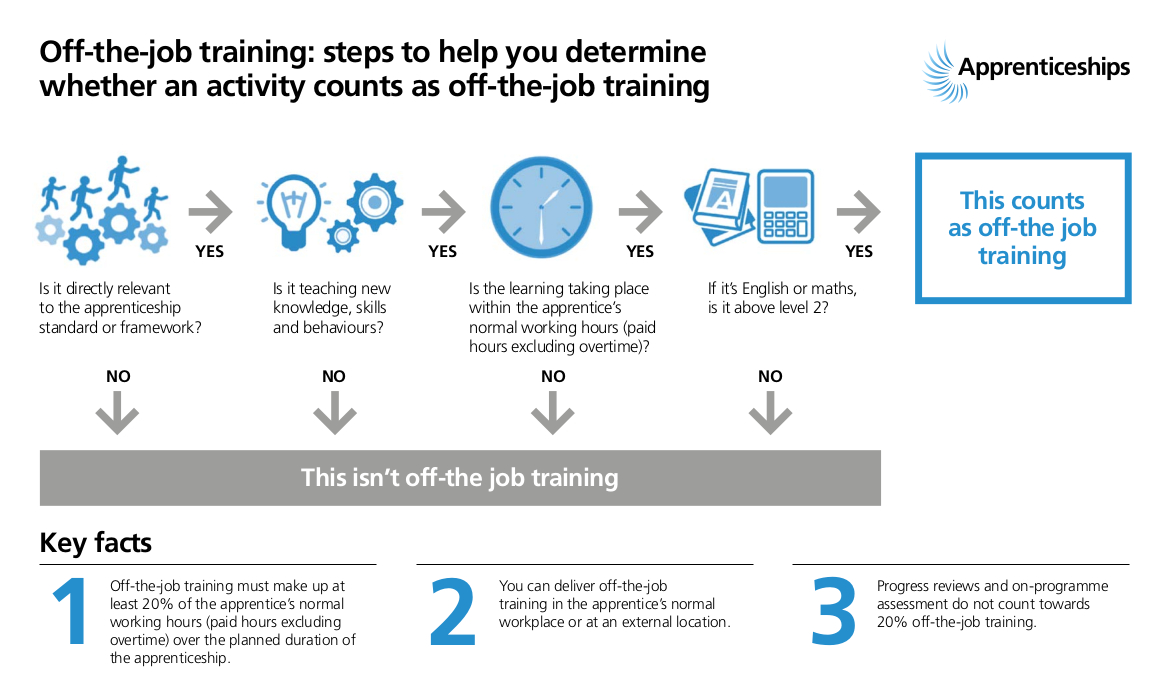
Off-the-job training but not off the clock
A common question from employers and apprentices is around the 20% off-the-job training that every apprenticeship standard must contain. We dive into what off-the-job training is plus highlight our top 10 aspects of work that can be used.
The DfE define off-the-job as ‘learning which is undertaken outside of the normal day-to-day working environment and leads towards the achievement of an apprenticeship.’
Much of the confusion comes from the phrase ‘off-the-job’ as employers often jump to the conclusion that this learning in done in addition to the apprentice’s hours. There is also some confusion as it refers to ‘normal day-to-day working environment’ and employers presume this means it has to be completed away from the work place. Neither of these are true. Off-the-job training hours can by logged whilst the apprentice is in the work place and must be logged within their normal working hours. Much of the learning that takes place will be part of for their development so meeting the requirement is not always as hard as it sounds.
How is the 20% calculated?
Off-the-job training is calculated using the apprentice’s contracted employment hours across their whole apprenticeship. By way of example, an off-the-job hours’ calculation might be; 52 weeks less 5 weeks’ holiday = 47 weeks’ x 37 hours per week = 1,739 x 0.2 = 347.8 off-the-job hours required per year.
For new start apprentices, this is relatively straight forward as employers can generally work the time into the expected productivity of that apprentice. It is more of a challenge for employers who are using apprenticeships to upskill their existing staff. They have to plan a drop in that person’s productivity in order to allow them to train. Of course, if the long term benefit of upskilling the employee outweighs the short term loss of productivity then it is a positive move for all involved.
What counts as off-the-job training?
To start with, let’s get the easy hours logged. Any college learning attended by the apprentice can be logged as off-the-job hours. The apprentice attends college during their normal working hours, it is learning that is taking place outside their normal working responsibilities and is going toward achieving their apprenticeship so counts at off-the-job training. This is great providing the apprenticeship has a college element!
Within the apprentice’s working week there are also opportunities to plan off-the-job learning. For apprenticeships where there is no college element, all off-the-job hours have to be planned and logged via in-company learning. For example; online learning or CPD related to their job, simulation exercises, manufacturer training, shadowing colleagues, being mentored, industry visits, learning support and time spent writing assignments can all be used – see our top ten below.
Remember, it must be within an apprentice's normal working hours, be increasing their knowledge but not be part of the day to day ‘work’ required within their role.
There are a number of things that can’t be used such as the study of English and maths (Functional Skills) up to level two, the work done with the apprenticeship provider to progress, review and asses the apprentice and training that takes place outside the apprentice’s paid working hours.
Identifying and logging hours
We help our employers and apprentices to identify and log their off-the-job learning. Our e-portfolio system has a handy phone app. that allows the apprentice to log the learning in real time. Logging hours as they happen or at the end of the day on which they occur is the best piece of advice that we give to apprentices. Having to think back and remember what was done last week or the weeks and months before that makes keeping track of off-the-job hours very difficult. Having up to date records also helps to track if they are on target to meet the hours required, or not.
From an employer’s point of view, there is no uniform way in which to structure giving learners opportunities or time to log off-the-job hours. It might be that two hours are logged in one week then twelve in the next due to work commitments and training opportunities. This is fine, as the hours are the overall amount achieved across the whole apprenticeship, not what is achieved on a weekly basis. That’s not to say you shouldn’t plan or break the requirement into weekly or monthly chunks to make it more manageable. Again, we help our employers to plan in order to meet the requirements of the apprenticeship.
Top 10 Off-the-job training aspects
So to finish, here are our top 10 in-work aspects that can be planned and logged as off-the-job training.
- Study time to complete job write ups, coursework, knowledge questions, preparing for assessments etc.
- Being mentored by a senior colleague
- Shadowing a senior colleague
- Online webinars relevant to their role or the industry sector from which they can gain new knowledge
- Manufacturer training – machinery, tools, materials etc.
- Training sessions e.g. Manual Handling, First Aid, Mental Health etc.
- 1:1 meetings and/or performance reviews
- Visits to other businesses or different business units
- Mentoring of another colleague (good for apprentices studying at L4 and above)
- Research tasks to gain new industry knowledge

Flow chart from the National Apprenticeships Service: off-the-job training guidance on GOV.UK
Written by Mark, CEO.
